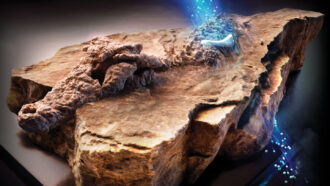Pyramids’ blocks: Possibly rock ‘n’ rolled
To move giant stones across the sand, ancient Egyptians may have found it easier to roll rather than drag them

Ancient Egyptians built the pyramids with millions of large, heavy stones. Some scientists now thing those blocks were rolled to the site.
holgs/ISTOCKHOTO
No one knows for sure how the ancient Egyptians built the pyramids that rise high above the desert near Cairo. But a new study suggests they used a little rock ‘n’ roll. Long-ago builders could have attached wooden posts to the stones and rolled them across the sand, the scientists say.
“Technically, I think what they’re proposing is possible,” concludes physicist Daniel Bonn, who did not work on the new study. “A lot of things are possible,” he told Science News. Bonn works at the University of Amsterdam, in the Netherlands.
People have long puzzled over how the Egyptians moved such massive rocks. And there’s no obvious answer. On average, each of the two million big stones in the Great Pyramid at Giza weighed about as much as a large pickup truck. The Egyptians somehow hauled those limestone blocks to the pyramid site from rock quarries a kilometer (0.6 mile) or more away.
The leading argument has held that Egyptian workers slid the blocks along slick paths. These would have resembled long Slip ‘N Slides — but ones made from desert materials. Many scientists suspect workers first would have put the blocks on sleds. Then they would have dragged them along ramps. To ease the blocks along, workers may have lubricated the ramps either with wet clay or with the fat from cattle. Bonn has now tested this idea by building small sleds and dragging heavy objects over sand.
Evidence from the sand near Giza supports this idea. Researchers found small amounts of fat, as well as chunks of limestone and the remains of ramps. And ancient temples contain drawings that show people using sleds to move giant statues.
However, Joseph West thinks there might have been a simpler way. A physicist at Indiana State University in Terre Haute, he led the new study. West said he was inspired while watching a television program showing how sleds might have helped with pyramid construction.
He told Science News: “I thought, well gosh, ‘Why don’t they just try rolling the things?’”A square could be turned into a rough sort of wheel by attaching wooden rods to its sides, he realized. That, he notes, should make a block of stone “a lot easier to roll than a square.”
So he tried it.
He and his students tied three dowel rods to each of four sides of a 30-kilogram (66-pound) limestone or concrete block. That action turned the block’s cross-section into a dodecagon, or 12-sided figure. Then they placed the block on the ground, like a spool of thread lying on its side.
They wrapped one end of a rope around the block and pulled. The researchers found they could easily roll the block over grass, gravel and hard-packed dirt. They calculated that rolling the block required about as much force as moving it along a slippery path. West’s team posted its findings August 14 on arXiv.org. (Many scientists use this online server to share their recent research.)
West isn’t the first scientist to think about rolling blocks to the pyramids. Earlier researchers, however, did not measure the force needed to overcome the friction of the stone rubbing against the sand. In physics, force is a measure of the effort needed to move an object or change its movement.
West hasn’t tested his idea on larger blocks, but he thinks rolling has clear advantages over sliding. For instance, workers wouldn’t have needed to carry cattle fat or water to lubricate the ramps.
Archaeologist Richard Redding works at the University of Michigan in Ann Arbor. He says West’s rolling-rocks hypothesis is the latest in a long history of ideas about the pyramids. “People see the pyramids as a great mystery,” he told Science News. In hopes of solving it: “They’re always coming up with new ideas about how they’re built.”
Power Words
archaeology The study of human history and prehistory through the excavation of sites and the analysis of artifacts and other physical remains.
concrete To be solid and real. (in construction) A simple, two-part building material. One part is made of sand or ground-up bits of rock. The other is made of cement, which hardens and helps bind the grains of material together.
dodecagon A plane figure with 12 sides.
force Some outside influence that can change the motion of a body or produce motion or stress in a stationary body.
friction The resistance that one surface or object encounters when moving over or through another material (such as a fluid or a gas). Friction generally causes a heating, which can damage the surface of the materials rubbing against one another.
limestone A natural rock formed by the accumulation of calcium carbonate over time, then compressed under great pressure. Most of the starting calcium carbonate came from the shells of sea animals after they died. However, that chemical also can settle out of water, especially after carbon dioxide is removed (by plants, for instance).
physics The scientific study of the nature and properties of matter and energy.
pyramid A monumental structure with a square or triangular base and sloping sides that meet in a point at the top. The best known are those made from stone as royal tombs in ancient Egypt.







